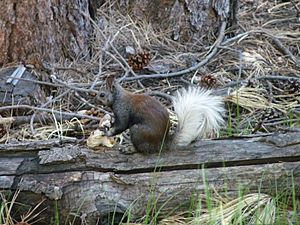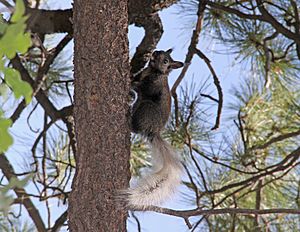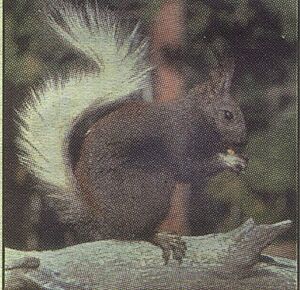Kaibab squirrel facts for kids
Quick facts for kids Kaibab squirrel |
|
|---|---|
 |
|
| Scientific classification |
|
| Kingdom: | Animalia |
| Phylum: | Chordata |
| Class: | Mammalia |
| Order: | Rodentia |
| Family: | Sciuridae |
| Genus: | Sciurus |
| Species: | |
| Subspecies: |
S. a. kaibabensis
|
| Trinomial name | |
| Sciurus aberti kaibabensis (Merriam, 1904)
|
|
The Kaibab squirrel (Sciurus aberti kaibabensis) is a special type of squirrel with cool ear tufts. It lives only in a small area called the Kaibab Plateau in the Southwestern United States. This area is about 20 by 40 miles (32 by 64 km). You can find these squirrels only in the ponderosa pine forests on the North Rim of Grand Canyon National Park and the northern part of Kaibab National Forest. This makes them super unique because they are not found anywhere else in the world! In 1965, a huge area of their home, about 200,000 acres (809 km²), was made a special place called the Kaibab Squirrel National Natural Landmark.
Contents
What Does the Kaibab Squirrel Look Like?
Kaibab squirrels are easy to spot! They usually have a black belly, though sometimes it can be gray. Their tail is white, and their head is a chestnut brown color.
One of their most interesting features is their tufted ears. These ear tufts grow longer as the squirrel gets older. In winter, they can stick out 1 to 2 inches (2.5 to 5 cm) above the ears. In summer, these tufts might not be visible at all.
Where Do Kaibab Squirrels Live and What Do They Eat?
The Kaibab squirrel makes its home in ponderosa pine forests. They build their nests high in the trees using twigs and pine needles.
These squirrels, the ponderosa pine trees, and the fungi that grow nearby all help each other. This is called a symbiotic relationship. The squirrels eat many things, including acorns, fruit, and different kinds of fungi (especially a type of underground truffle). They also munch on the seeds, bark, and twigs from the trees where they live. The most important food for the Kaibab squirrel is the seeds found inside ponderosa pine cones.
Young squirrels are usually born between April and August.
How Did the Kaibab Squirrel Become Unique?
The Kaibab squirrel was once thought to be its own species (Sciurus kaibabensis). But today, scientists consider it a subspecies of the Abert's squirrel (Sciurus aberti).
The Kaibab squirrel is a great example of evolution happening because of geographic isolation. This means a group of animals gets separated, and over time, they change and become different from their relatives.
Many people used to think the Grand Canyon itself separated the Kaibab squirrels on the North Rim from other Abert's squirrels on the South Rim. However, it's a bit more complicated! Modern Kaibab squirrels came from Abert's squirrels that moved into the Grand Canyon area after the last Ice Age.
As the climate got warmer, the ponderosa pine forests and the Abert's squirrels living there could only survive in high, cool places like the Kaibab Plateau. These isolated groups of squirrels eventually became the Kaibab squirrels we see today. Later, when the climate cooled again, ponderosa pines grew at lower elevations once more. Other Abert's squirrel subspecies returned to the Grand Canyon area, filling their old homes on the South Rim.
See also
 In Spanish: Ardilla de Kaibab para niños
In Spanish: Ardilla de Kaibab para niños



